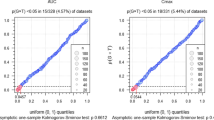Abstract
With a quantal response, the dose-response relation is summarized by the response probability function (RPF) that provides probabilities of the response being reacted as a function of dose levels. In the dose-response analysis (DRA), it is often of primary interest to find a dose at which targeted response probability is attained, which we call target dose (TD). The estimation of the TD clearly depends on the underlying RPF structure. In this article, we provide a comparative analysis of some of the existing and newly proposed RPF estimation methods with particular emphasis on TD estimation. Empirical performances based on simulated data are presented to compare the existing and newly proposed methods. Nonparametric models based on a sequence of Bernstein polynomials are found to be robust against model misspecification. The methods are also illustrated using data obtained from a toxicological study.
Similar content being viewed by others
References
Ahn, Η., and J. J. Chen. 1997. Tree-structured logistic model for over-dispersed binomial data with application to modelling developmental effects. Biometrics 53 (2):435–55.
Bailer, A. J., R. B. Noble, and M. W. Wheeler. 2005. Model uncertainty and risk estimation for experimental studies of quantal responses. Risk Analysis 25 (2):291–99.
Bornkamp, B., and K. Ickstadt. 2009. Bayesian nonparametric estimation of continuous monotone functions with applications to dose-response analysis. Biometrics 65 (1):198–205.
Bretz, F., J. C. Pinheiro, and M. Branson. 2005. Combining multiple comparisons and modeling techniques in dose-response studies. Biometrics 61 (3):738–48.
Brown, B. M., and S. X. Chen. 1999. Beta-bernstein smoothing for regression curves with compact support. Scandinavian Journal of Statistics 26 (1):47–59.
Carnicer, J. M., and J. M. Peña. 1993. Shape preserving representations and optimality of the bernstein basis. Advances in Computational Mathematics 1 (2):173–96.
Cornfield, J. 1977. Carcinogenic risk assessment. Science 198 (4318):693–99.
Cox, C. 1987. Threshold dose-response models in toxicology. Biometrics 43 (4):511–23.
Dette, H., N. Neumeyer, and K. F. Pilz. 2005. A note on nonparametric estimation of the effective dose in quantal bioassay. Journal of the American Statistical Association 100 (470):503–10.
Farouki, R. T. 2012. The bernstein polynomial basis: A centennial retrospective. Computer Aided Geometric Design 29 (6):379–419.
Gasparini, M., and J. Eisele, 2000. A curve-free method for phase I clinical trials. Biometrics 56 (2):609–15.
Hall, P., and L.-S. Huang. 2001. Nonparametric kernel regression subject to monotonicity constraints. Annals of Statistics 29 (3):624–47.
Holson, J., T. Gaines, C. Nelson, J. LaBorde, D. Gaylor, D. Sheehan, and J. Young 1992. Developmental toxicity of 2, 4, 5-trichlorophenoxyacetic acid (2, 4, 5-T) I. Multireplicated dose- response studies in four inbred strains and one outbred stock of mice. Toxicological Sciences 19 (2):286–97.
Hyndman, R. J. 1996. Computing and graphing highest density regions. American Statistician 50 (2):120–26.
Lorentz, G. G. 2012. Bernstein polynomials. 2nd ed. New Yok, NY: AMS Chelsea Publishing.
Macdougall, J. 2006. Analysis of dose-response studies-Emax model. In Dose finding in drug development, ed. N. Ting, 127–145. New York, NY: Springer.
Mammen, E., J. Marron, Β. Turlach, Μ. Wand, et al. 2001. A general projection framework for constrained smoothing. Statistical Science 16 (3):232–48.
McKay, C. S., and S. K. Ghosh. 2011. A variable selection approach to monotonic regression with bernstein polynomials. Journal of Applied Statistics 38 (5):961–76.
Mukerjee, H. 1988. Monotone nonparametric regression. Annals of Statistics 16 (2):741–50.
Müller, H.-G., and T. Schmitt. 1988. Kernel and probit estimates in quantal bioassay. Journal of the American Statistical Association 83 (403):750–59.
Perron, F., and K. Mengersen. 2001. Bayesian nonparametric modeling using mixtures of triangular distributions. Biometrics 57 (2):518–28.
Peto, R. 1977. Epidemiology, multistage models, and short-term mutagenicity tests. Origins of Human Cancer 4:1403–28.
Pinheiro, J. C., F. Bretz, and M. Branson. 2006. Analysis of dose-response studies: Modeling approaches. In dose finding in drug development, ed. N. Ting, 146–171. New York, NY: Springer.
Rai, K., and J. Van Ryzin. 1979. Risk assessment of toxic environmental substances using a generalized multi-hit dose response model. In Energy and Health, ed. Ν. Ε. Breslow, 99–117. Philadelphia, PA: SIAM Press.
Ramsay, J. O. 1988. Monotone regression splines in action. Statistical Science 3 (4):425–41.
Shao, J., and D. Tu. 2012. The jackknife and bootstrap. New York, NY: Springer Science & Business Media.
Stadtmüller, U. 1986. Asymptotic properties of nonparametric curve estimates. Periodica Mathematica Hungarica 17 (2):83–108.
Tenbusch, A. 1997. Nonparametric curve estimation with bernstein estimates. Metrika 45 (1):1–30.
Thompson Jr., W., and R. Funderlic. 1981. A simple threshold model for the classical bioassay problem. Measurement of Risks 521–533. New York, NY: Springer.
Ting, N. 2006. Dose finding in drug development. New York, NY: Springer.
Wang, J. and S. Ghosh. 2012. Shape restricted nonparametric regression with bernstein polynomials. Computational Statistics & Data Analysis 56 (9):2729–41.
Wang, X., and F. Li. 2008. Isotonic smoothing spline regression. Journal of Computational and Graphical Statistics 17 (1):21–37.
White, H. 1982. Maximum likelihood estimation of misspecified models. Econometrica 50 (1):1–25.
Author information
Authors and Affiliations
Corresponding author
Additional information
Color versions of one or more of the figures in the article can be found online at https://doi.org/www.tandfonline.com/ujsp.
Rights and permissions
About this article
Cite this article
Shin, S.J., Ghosh, S.K. A comparative study of the dose-response analysis with application to the target dose estimation. J Stat Theory Pract 11, 145–162 (2017). https://doi.org/10.1080/15598608.2016.1261260
Received:
Accepted:
Published:
Issue Date:
DOI: https://doi.org/10.1080/15598608.2016.1261260




